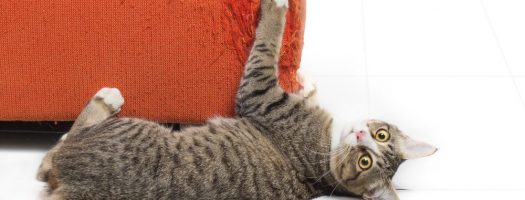How Do You Get Rid of Fleas on a Cat?

If your furry feline friend has fleas, you are well aware that they can be much more than just a nuisance. In fact, in as little as 30 days, ten fleas can multiply to create a full-on infestation of over 250,000 pests on your pet, as well as around your home. These pesky insects can irritate your pet’s skin and leave them an itchy, uncomfortable mess.
So how can you prevent these unwelcome guests from bothering you and your beloved pets? Here are several tried and true methods to quickly spot fleas on your cat and stop them at the source. Here is everything you will need to know to keep you and your friend free of fleas, quickly and safely.
How Can You Get Rid of Fleas?
When it comes to helping your cat avoid any serious flea-related issues, getting rid of the infestation entirely is your only guaranteed defense. There are several traditional methods as well as a few clever home remedies that can effectively treat the current outbreak. These treatments will also make any new fleas think twice before entering your home.
Remember, before trying any medication or home remedies, be sure to consult with your cat’s veterinarian first. You want what is best for your pet, and your vet will know what route to take to keep your cat healthy.
Standard Treatments
The first step in ridding your pet of fleas should always be to treat your pet and their things, even if your pet does not show apparent signs of infestation.
- Consider a flea and tick collar: These collars are generally quite safe for pets and can aid in killing fleas, larvae, eggs, and even ticks. It also helps to repel insects and keep them off of your pet’s skin in the first place.
- Shampoos or topical treatments: Topical treatments and flea shampoos are common ways to kill all of the adult fleas as well as eggs and lice. These treatments will also prevent new fleas from hatching.
- Flea medicine: Your vet might prescribe your cat a chewable flea pill. In most cases, these are also available over the counter. These medications will provide your pet with a fast-acting solution to provide relief from flea symptoms and kill the fleas at the source.
Treating Your (Pet’s) Home
You must treat not only your pet but also your (pet’s) home as well. If you do not rid your pet’s habitat of all the fleas and flea larvae, they will return, and the cycle will repeat.
- Use a spray or flea powder on your bedding: It is crucial to treat any areas where your cat may have been in the past. This includes your bedding, carpets and upholstery.
- Clean your cat’s bed: Treat your cat’s bed for fleas, and be sure to wash it often. Hot water works best for getting rid of fleas and eggs.
- Vacuum the whole house: Getting rid of all traces of fleas is critical. To do this, vacuum all floors, furniture, rugs, and carpets. Dispose of the vacuum cleaner bags to prevent any eggs from hatching in the house.
- Call an expert: If the infestation is severe, you should consider contacting an expert exterminator to rid your home of pesky fleas by deep treating the source.
Home Remedies
Many pet owners are concerned about treating their home and their pet with harsh chemicals and medications. Many traditional treatments can have potential side effects for your pet or members of the family. If you have tried commercial products to no avail, there are several do-it-yourself approaches to help tame the fleas in your home and on your pet. Here are some fantastic and effective home remedies that you can use to banish the bugs and help your cat find relief from flea infestation.
Cedar Chips
Cedar chips have long been known to repel fleas – but there is also the chance that your cat might be repulsed by the smell as well. One great way to use cedar chips is to slowly introduce them to your cat’s bedding, as well as the outside perimeter of your house.
Additionally, cedar oil spray is a non-toxic essential oil that is safe to spray directly on your cat’s coat. You can also sprinkle a few drops of oil on a dry banana peel or around your cat’s collar to keep the fleas from feasting.
Lemons
As simple as it sounds, lemons are one of the most effective defenses against flea invaders. The natural citric acid has long been used to kill and repel fleas. To make a cat-friendly spray, start by boiling 1-2 cut lemons, let them steep and cool, then transfer the liquid to a spray bottle.
Gently spray and work in the solution into your cat’s coat, carefully avoiding direct skin contact and eyes. Be sure to monitor your pet for any signs of irritation as some cats are more sensitive than others. If your cat takes to the solution well, you can repeat this treatment as often as necessary. The fresh, fragrant scent is an added bonus.
What if your cat hates water? Try dipping a plastic comb in the citrus solution and gently brush the fleas out of your cat’s fur. If you want to get rid of any remaining fleas or eggs, wash your cat’s bedding with about a cup of the lemon solution to kill any leftover pests.
Common Spices
One of the easiest and simplest ways to rid your cat of fleas is to take a trip to your kitchen cabinet. Some common herbs and spices can be used to rid your pet of their fleas naturally.
- One such helpful herb is oregano oil, which contains a flea killing compound called carvacrol. To make your spicy solution, mix one teaspoon of oregano oil with about three teaspoons of olive oil. Apply this mixture to all of your pet’s flea hotspots such as the tail, neck, stomach, or ears.
- If you don’t have any oregano oil, try grinding some rosemary leaves down to a fine powder. Sprinkle this powder in all of the areas that your cat likes to hang out around the house. The scent of the rosemary will naturally repel fleas.
- If your cat is very territorial or will not let you safely apply fur treatments, you can always try to mix a small amount of cumin in their food. Mix no more than a teaspoon with their average amount of food. Cumin tends to make a cat’s skin unappetizing to hungry fleas.
- If you don’t have any of these items in your kitchen, even a pinch of table salt can be handy. Table salt serves to dehydrate the fleas on your cat, which will kill them naturally. If you sprinkle it into your carpet, it will have the same effect on the eggs and larvae. Lastly, you can mix a pinch of table salt with water to treat any hard surfaces your cat may have visited.
Apple Cider Vinegar
You may be aware of the versatility of apple cider vinegar, but did you know that it is effective in deterring fleas from making your cat their home? It should be noted that ACV will not kill the pests, but it will make them abandon their host. From there, it is much easier to tackle the issue effectively.
To make an apple cider vinegar spray, mix the ACV with water at a ratio of 2:1. Once mixed, you can use the spray to cover your cat’s fur lightly. Gently comb the mixture through the coat to ensure an even coating. Fleas are well known to be quite stubborn, so you might need to repeat this process several times. After a few ACV treatments, your cat’s fur should be pest-free.
Once you are finished treating your cat’s fur, don’t forget to thoroughly vacuum all of the upholstery and all floors of the house. Wash all the bedding in the house with hot water and remove any source of outside food that will attract flea carriers to your home. Remember that the ACV treatment only makes fleas relocate. Hence, proper and thorough cleaning is essential if you choose this treatment.
Liquid Dish Soap
Dish soap is not generally known as a versatile kitchen agent; however, even gentle varieties of dish soap are effective in eliminating fleas from pets. The dish soap formulation dissolves the flea’s hard exoskeleton and can kill the pests within minutes.
To use the dish soap method, simply soak your cat’s fur and gently lather in the dish soap. Be sure to focus on the tough to reach areas of skin that fleas love to hide, then gently rinse off the soap.
If you are looking to catch any of the stragglers that may have escaped, you can make a soapy trap. Fill a small dish with warm water and mix in a small amount of dish soap. Place the bowl near a light source. The fleas will be attracted to the light and then drown in the soapy liquid upon contact.
How Can You Tell If Your Cat Has Fleas?
If you are unsure whether your cat is suffering from a flea infestation or not, some telltale signs will allow you to confirm the presence of the culprits. Although it is not extremely difficult to verify, it will take a bit of investigation.
Fleas are tiny and can be hard to spot. They measure a mere 1/12 – 1/16” in length, and their reddish-brown tint might even blend in with the color of your cat’s fur. Instead of trying to spot fleas visually, you can rely on these more common signs of a flea infestation:
- Excessive scratching or itchy/dry skin: It does not take an army of fleas to make your cat scratch excessively. Even a handful of fleas can make your cat itchy and uncomfortable. Your pet might be allergic to the flea’s saliva, which can cause skin sensitivity or even small itchy bumps on your cat’s skin.
- Increased biting on fur or around legs: Your cat has no idea how to handle these invaders. They may resort to gnawing the hair around their feet or legs to find some relief.
- Hair loss in patches (mostly around the neck or tail): If your cat is allergic, they may start to lose hair as a reaction to the flea’s saliva. Your cat’s scratching can exaggerate this reaction in these areas.
- Sluggishness or lethargy: Although this can be a troublesome symptom to diagnose in most cats, it can be a sign of a severe infestation. One single flea can bite over one hundred times a day. Each time a flea bites, it also draws blood from its host. In acute situations, this loss of blood can lead to feline anemia, which causes sluggishness.
- Visual tells: When the infestation gets bad enough, you will be able to see light-colored specks through your cat’s fur, or in their bedding. These specks are the flea’s eggs. You will also be able to spot small pepper-like bits which indicate flea feces. Lastly, you will be able to locate the insects themselves if you brush your cat’s coat against the grain.
Say Goodbye to Fleas on Your Cat
Unfortunately, cats cannot tell their owners about their flea infestation outright, and they can end up being quiet sufferers. It is incredibly important to pay attention to the signs and behaviors of your cat to be aware when they are experiencing a critical flea infestation.
Remember to consult with your veterinarian before deciding on flea treatment. Your vet will help you decide on the best course of action. If you or your cat are sensitive to chemicals or medications, several natural home remedies can be useful in expelling pesky fleas. Ridding your pet of fleas will ensure that your cat is healthy and stress-free.




